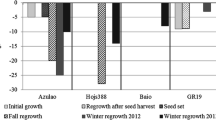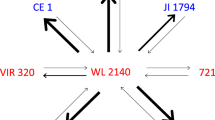Abstract
Hybrid aspen (Populus tremula × P. tremuloides) belong to the section Populus. Eastern cottonwood (P. deltoides) is a member of the section Aigeiros within the genus Populus. These poplar sections are generally considered to be incompatible. Here, we describe successful hybridisation between these parents, producing an offspring family with 27 individuals. The hybrid character of individuals was proven by genotypes at 16 nuclear microsatellite loci. One individual was suspected to have more than the diploid chromosome number of 2n = 38 due to the observation of more than two alleles at several loci. This individual is a triploid, ascertained by flow cytometry. Two distinct growth classes of tall and dwarf plants were observed in the progeny, reflecting different degrees of postzygotic incompatibility. Two loci linked to the tested microsatellites have an effect on height growth. Some fast-growing individuals were micropropagated to test them for biomass performance together with other clones in field trials.





Similar content being viewed by others
References
Dayanandan S, Rajora OP, Bawa KS (1998) Isolation and characterization of microsatellites in trembling aspen (Populus tremuloides). Theor Appl Genet 96:950–956. doi:10.1007/s001220050825
de-Lucas AI, Santana JC, Recio P, Hidalgo E (2008) SSR-based tool for identification and certification of commercial Populus clones in Spain. Ann For Sci 65:107. doi:10.1051/forest:2007079
Eckenwalder JE (1996) Systematics and evolution of Populus. In: Stettler RF, Jr Bradshaw HD, Heilmann PE, Hinckley TM (eds) Biology of Populus and its implications for management and conservation. NRC Research Press, National Research Council of Canada, Ottawa, pp 7–32
Ewald D, Ulrich K, Naujoks G, Schröder MB (2009) Induction of tetraploid poplar and black locust plants using colchicine: chloroplast number as an early marker for selecting polyploids in vitro. Plant Cell Tiss Organ Cult 99:353–357. doi:10.1007/s11240-009-9601-3
Knox RB, Willing RR, Pryor LD (1972) Interspecific hybridization in poplars using recognition pollen. Silv Genet 21:65–69
Lexer C, Fay MF, Joseph JA, Nica MS, Heinze B (2005) Barrier to gene flow between two ecologically divergent Populus species, P. alba (white poplar) and P. tremula (European aspen): the role of ecology and life history in gene introgression. Mol Ecol 14:1045–1057. doi:10.1111/j.1365-294X.2005.02469.x
Liesebach M, Naujoks G (2004) Approaches of difficult-to-root Salix caprea. Plant Cell Tiss Organ Cult 79:239–247. doi:10.1007/s11240-004-0665-9
Liesebach H, Schneck V, Ewald E (2010) Clonal fingerprinting in the genus Populus L. by nuclear microsatellite loci regarding differences between sections, species and hybrids. Tree Genet Genomes 6:259–269. doi:10.1007/s11295-009-0246-5
Rae AM, Street NR, Robinson KM, Harris N, Taylor G (2009) Five QTL hotspots for yield in short rotation coppice bioenergy poplar: The Poplar Biomass Loci. BMC Plant Biology 9:1–13. doi:10.1186/1471-2229-9-23
Rahman MH, Rajora OP (2002) Microsatellite DNA fingerprinting, differentiation, and genetic relationships of clones, cultivars, and varieties of six poplar species from three sections of the genus Populus. Genome 45:1083–1094. doi:10.1139/G02-077
Rahman MH, Dayanandan S, Rajora OP (2000) Microsatellite DNA markers in Populus tremuloides. Genome 43:293–297
Ronald WG (1982) Intersectional hybridization of Populus sections, Leuce-Aigeiros and Leuce-Tacamahaca. Silv Genet 31:94–99
SAS Institute Inc (2003) SAS for Windows 9.1.3. SAS Institute Inc, Cary
Smulders MJM, van der Schoot J, Arens P, Vosman B (2001) Trinucleotide repeat microsatellite markers for black poplar (Populus nigra L.). Mol Ecol Notes 1:188–190
Stettler RF (1968) Irradiated mentor pollen: its use in remote hybridization of black cottonwood. Nature 219:746–747
Stettler RF, Zsuffa L, Wu R (1996) The role of hybridization in the genetic manipulation of Populus. In: Stettler RF, HDJr Bradshaw, Heilmann PE, Hinckley TM (eds) Biology of Populus and its implications for management and conservation. NRC Research Press, National Research Council of Canada, Ottawa, pp 87–112
Tabbener HE, Cottrell JE (2003) The use of PCR based DNA markers to study the paternity of poplar seedlings. For Ecol Manag 179:363–376
Tuskan GA, Gunter LE, Yang ZK, Yin T, Sewell MM, DiFazio SP (2004) Characterization of microsatellites revealed by genomic sequencing of Populus trichocarpa. Can J For Res 34:85–93. doi:10.1139/X03-283
Van den Broeck A, Villar M, Van Bockstaele E, Van Slycken J (2005) Natural hybridization between cultivated poplars and their wild relatives: evidence and consequences for native poplar populations. Ann For Sci 62:601–613. doi:10.1051/forest:2005072
Van den Broeck A, Cottrell JE, Quataert P, Breyne P, Storme V, Boerjan W, Van Slycken J (2006) Paternity analysis of Populus nigra L. offspring in a Belgian plantation of native and exotic poplars. Ann For Sci 63:783–790. doi:10.1051/forest:2006060
van der Schoot J, Pospíšková M, Vosman B, Smulders MJM (2000) Development and characterization of microsatellite markers in black poplar (Populus nigra L.). Theor Appl Genet 101:317–322. doi:10.1007/s001220051485
von Wettstein-Westersheim W (1933) Die Züchtung von Populus II. Der Züchter 5:280–281
Wheeler N, Payne P, Hipkins VD, Saich R, Kenny S, Tuskan G (2006) Polymix breeding with paternity analysis in Populus: a test for differential reproductive success (DRS) among pollen donors. Tree Genet Genomes 2:53–60. doi:10.1007/s11295-005-0033-x
Willing RR, Pryor LD (1976) Interspecific Hybridisation in Poplar. Theor Appl Genet 47:141–151
Zhou CJ, Song HZ, Li JH, Sun JW, Jin DM, Zhang QW, Wang B (2005) Evaluation of Genetic Diversity and Germ Plasm Identification of 44 Species, Clones, and Cultivars From 5 Sections of the Genus Populus Based on Amplified Fragment Length Polymorphism Analysis. Plant Molecular Biology Reporter 23:39–51
Acknowledgments
The authors gratefully acknowledge helpful contributions of an anonymous reviewer to improve the manuscript.
Author information
Authors and Affiliations
Corresponding author
Additional information
Communicated by Scott Russell.
DedicationThis report is dedicated to Dr. Irmgard Eifler (at the Institute for Forest Tree Breeding in Waldsieversdorf from 1951 to 1983) who inspired us to combine new and previous knowledge to overcome obstacles in forest tree breeding.
Rights and permissions
About this article
Cite this article
Liesebach, H., Naujoks, G. & Ewald, D. Successful hybridisation of normally incompatible hybrid aspen (Populus tremula × P. tremuloides) and eastern cottonwood (P. deltoides). Sex Plant Reprod 24, 189–198 (2011). https://doi.org/10.1007/s00497-010-0156-6
Received:
Accepted:
Published:
Issue Date:
DOI: https://doi.org/10.1007/s00497-010-0156-6




